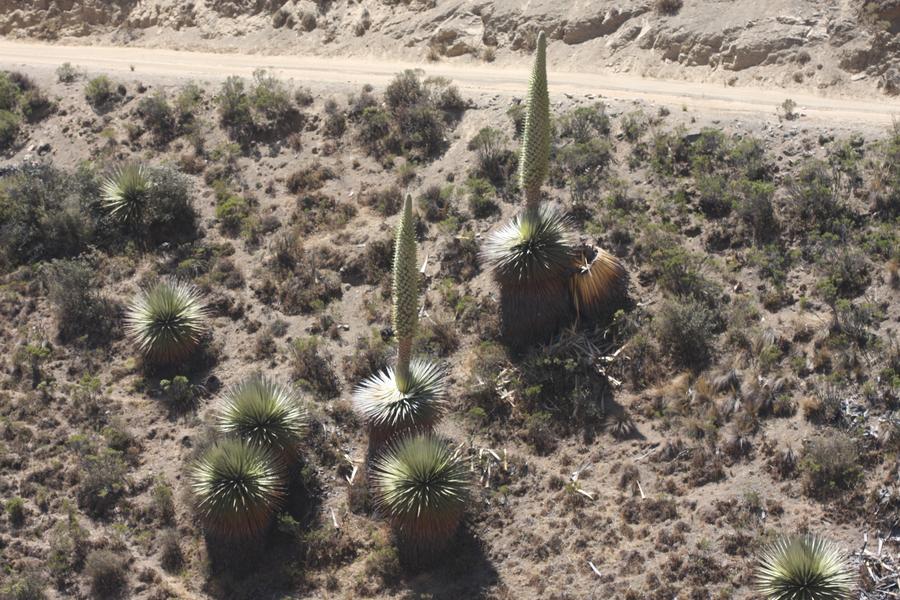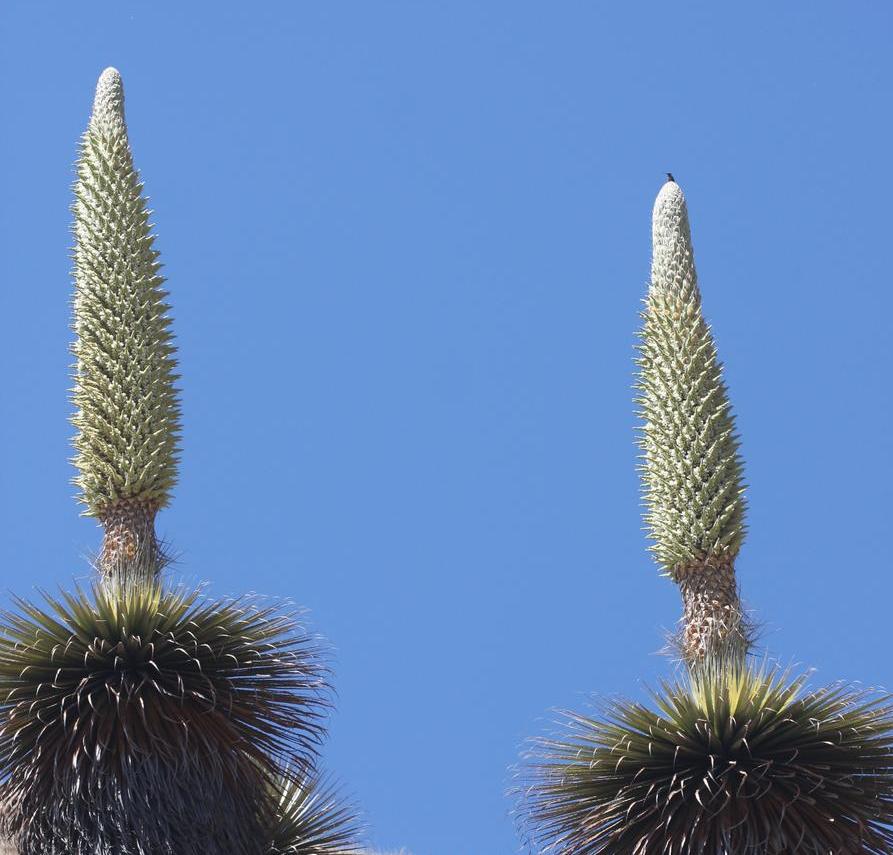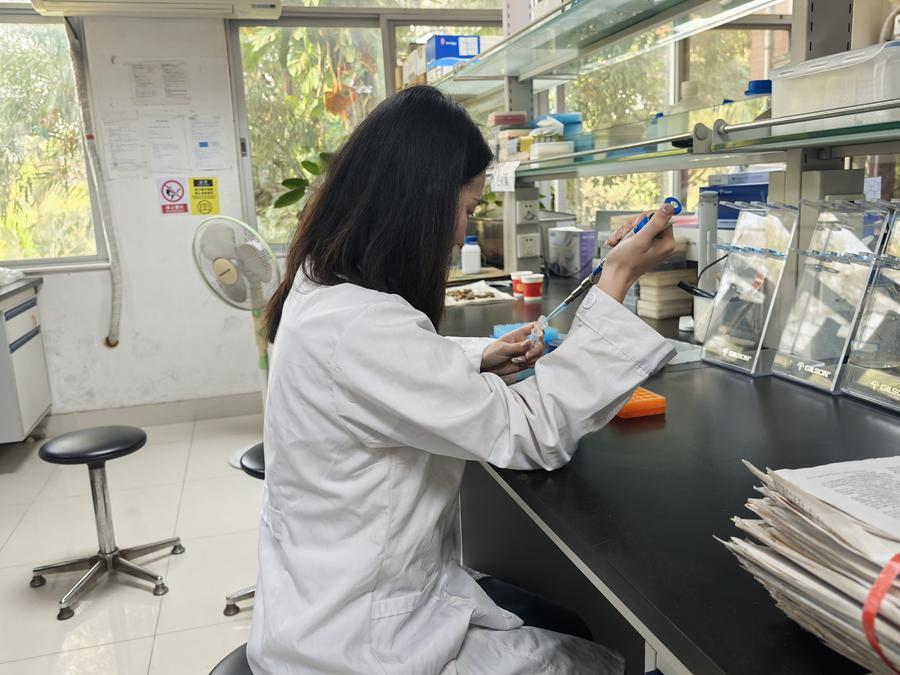"Treasure" plant drives China-Peru cooperation in biodiversity protection

This file photo taken on Nov. 9, 2018 shows Puya raimondii, known as the Queen of the Andes, in Peru. The plant is native to Peru and is regarded as a treasure. (Photo by Ge Xuejun/Xinhua)
GUANGZHOU, Nov. 18 (Xinhua) -- The South China Botanical Garden in Guangzhou is showcasing a meticulously curated shelf filled with various plant specimens all the way from Peru.
Affiliated with the Chinese Academy of Sciences, the garden now houses a diverse collection of 6,300 species samples from the Latin American country. However, just over 10 years ago, there were only a few hundred specimens. One standout item among them is a large yellow leaf from a bromeliad plant, known as the Queen of the Andes.
The plant is native to Peru and is regarded as a treasure. It can be found exclusively in the high Andes, at elevations ranging from 3,000 meters to 4,800 meters.
It is also a star species in the botanical world. According to Ge Xuejun, a researcher at the garden, this plant can grow to a height of over 10 meters, making it the largest bromeliad on Earth.
Peru is the birthplace of many endangered plant species, and a notable example is the well-known Cinchona tree. This tree is the source of quinine, a drug used in the treatment of early-stage malaria. Its image is printed on the country's national emblem and coins.

This file photo taken on Nov. 9, 2018 shows Puya raimondii, known as the Queen of the Andes, in Peru. (Photo by Ge Xuejun/Xinhua)
The Queen of the Andes is another plant that Peruvians take great pride in. This rare, long-lived species blooms just once in its lifetime, which can last anywhere from 40 to 100 years.
"The high Andes region was dry and cold, with sparse vegetation. However, the giant Queen of the Andes stood like a flourishing forest," Ge recalled his first encounter with the plant during field research in Peru in 2009. "We were fortunate to witness the recently deceased plant. Its seeds look like grains of rice, with millions of tiny seeds resembling millet."
Due to its limited genetic diversity and frequent destruction for logging and the creation of new pastures, the survival of the Peruvian plant is now at risk. Since 2010, researchers from China and Peru have collaborated on studies to safeguard these invaluable species.
In recent years, Ge and his team have collaborated with Peruvian researchers to publish papers on the genes and genetic conservation of these species.
Despite having never been to Latin America, Liu Lu, a PhD researcher in Ge's team, has devoted over six years to studying the Peruvian treasure. In August, the team she was involved in achieved significant progress in the plant's genomics research, leading to the publication of their research results in an international journal.
Liu said that the study used scientific methods to demonstrate the endangered status and extinction risk of species, as well as their adaptability to the natural environment. She added that these findings, which have been recognized by Peruvian scientists, will provide a scientific basis for formulating subsequent protection strategies for the Queen of the Andes.

Liu Lu, a PhD researcher of the Chinese Academy of Sciences, conducts a molecular experiment in the laboratory of South China Botanical Garden of the Chinese Academy of Sciences in Guangzhou, South China' Guangdong Province, on Nov. 11, 2024. (Xinhua)
China and Peru have been collaborating on research into tropical biodiversity and ecology since 2006. As one of the leading institutions for conserving plant germplasm in China, the Guangzhou-based garden has played a key role in this cooperation.
"After enduring a flight lasting over 20 hours, I discovered that everything in the Latin American country was unfamiliar to me; I was even unaware of the local street trees," Ge recalled, reflecting on their first research trip to Peru in December 2008.
Most places the Chinese plant research team ventured into were remote and inaccessible. Some of these areas remained unexplored by local researchers, and even experienced guides had gotten lost there. Unfamiliar paths, unidentified species and inhospitable environments became common challenges during their quest.
Despite the long distance and language barriers, the research trip was filled with delightful surprises for the Chinese plant researchers. "Latin America has an incredible richness of plant species. Of the world's more than 300,000 higher plant species, this region alone harbors over 110,000, surpassing tropical Africa and Asia in abundance," Ge said.
"Having a global perspective is crucial for biological research," Ge said, noting that the number of visits by Latin American scholars and researchers to the garden has reached nearly 100 since 2009.

This file photo taken on Nov. 9, 2018 shows Ge Xuejun (1st R), a researcher of the South China Botanical Garden of the Chinese Academy of Sciences, posing for a group photo with other researchers while conducting scientific research in Peru. (Xinhua)
Liscely Tumi is one of the participants in the China-Peru science exchanges. She studied the Queen of the Andes in Guangzhou and published her findings on genetic diversity in an international journal as the first author.
"I gained valuable experiences during the research, which helped me expand my research skills," Tumi told Xinhua. "It was not only an academic experience, I also had the chance to experience the beautiful Chinese culture, warm people and incredible biodiversity."
As exchanges and cooperation between researchers from both sides have become more frequent, Ge has come to realize that his work extends beyond academic research.
The Guangzhou-based botanical garden has signed agreements with various universities and research institutions in Latin America. It also organizes various science education activities to raise public awareness on biodiversity protection.
According to Ge, the research on ecological protection is a long-term endeavor, and the cooperation between China and Latin American countries requires patience.
"By establishing a strong foundation for collaboration and exchanges, we can effectively address the shared challenges in biodiversity conservation and sustainable development," Ge added.?
Photos
Related Stories
- Peruvian young man into Chinese lion dance
- Peru's Chancay Port opens new land-sea corridor between China and Latin America
- Chinese, Peruvian leaders inaugurate new megaport, boosting Latin America's trade links
- China to further ties with Peru: spokesperson
- Xi calls for upgrading practical cooperation between China, Peru
Copyright © 2024 People's Daily Online. All Rights Reserved.









